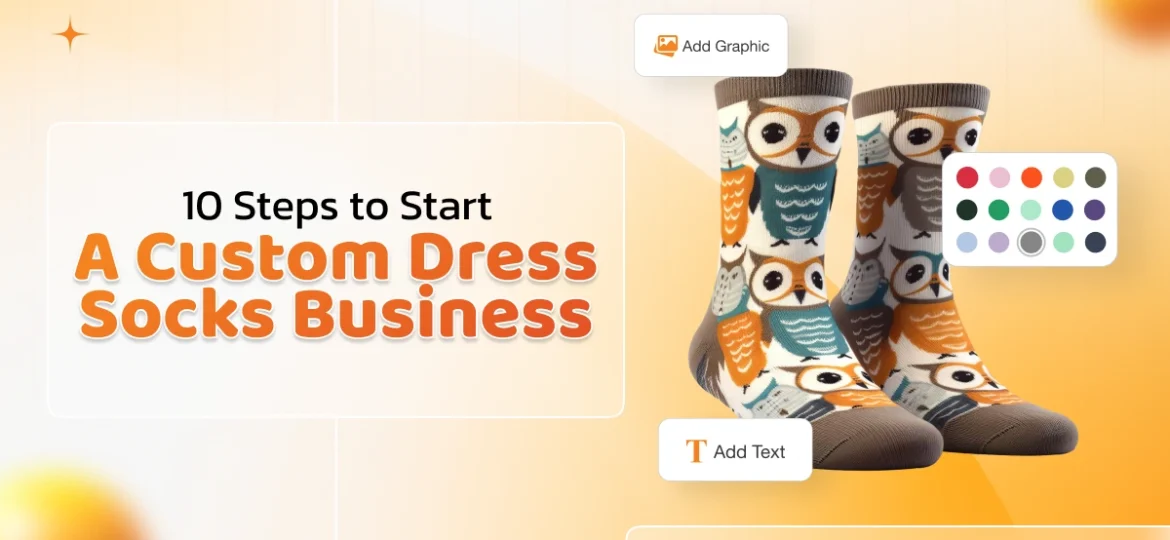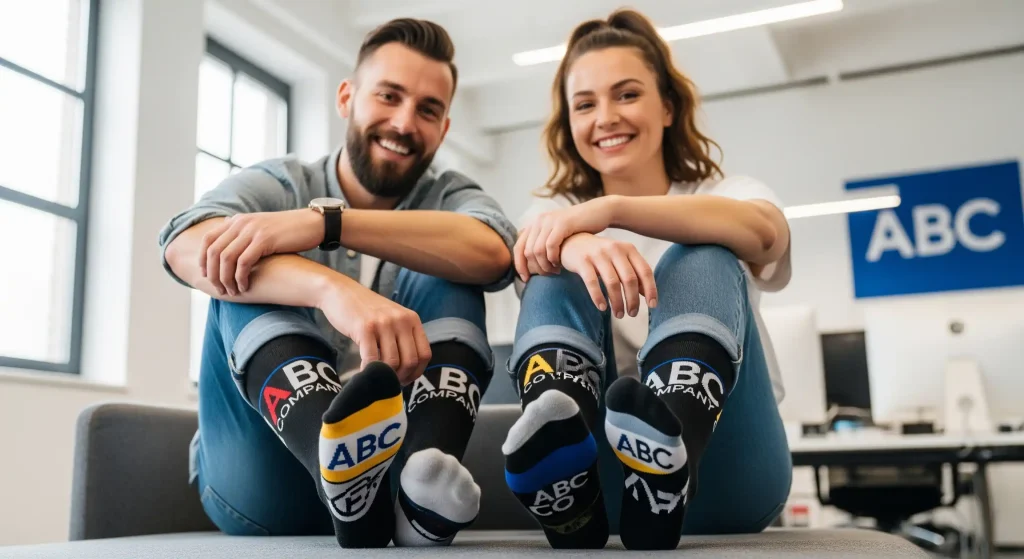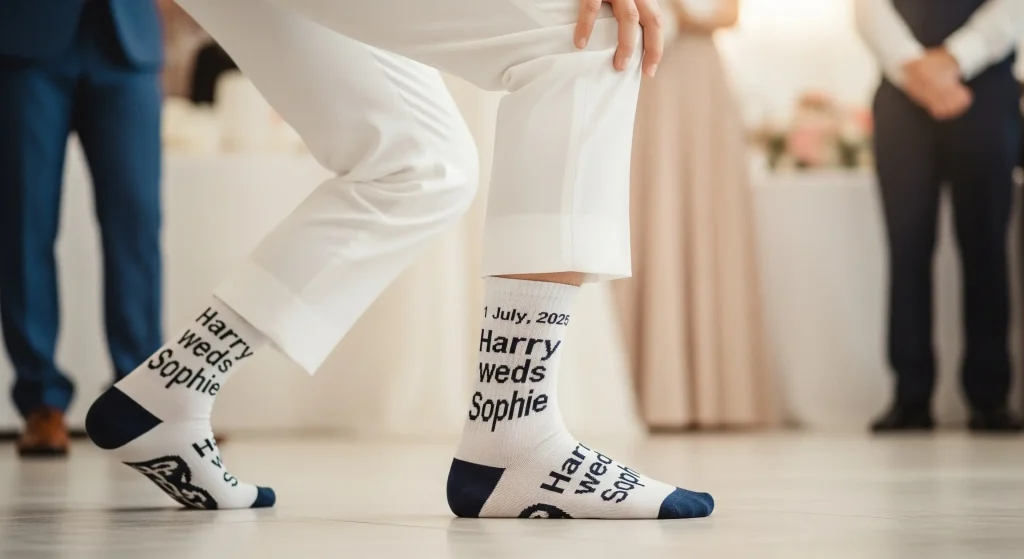
Comfort of Socks is usually an afterthought. Most people buy whatever is available. But that’s changing. These days, there’s a growing interest in socks that feel personal. Not just in how they fit, but in how they look. A small design. A name. A color that fits a mood or moment. That’s where custom dress socks come in.
It’s not a vibrant business, nor even saturated. You’re not selling sneakers or jackets. But there’s something special about it. People want useful things with a personal touch. A wedding gift. A company thank-you. Even just something different to wear to work. It makes sense. Starting a custom dress socks business doesn’t need a big team or a lot of money. Some people start with just a few ideas and test them online. Some find a local printer. Others use suppliers overseas. There are options.
You won’t find instant success. But if you care about design, if you’re okay starting small, there’s a real way here. This guide is just a simple list. Ten steps. You can follow all of them, or some. It’s up to you. But it should help you see the shape of what this kind of business could be.
Table of Contents
Step 1: Understand the Market and Trends
Starting a custom dress socks business without understanding the market is like walking in the dark. Before anything else, stop and look around. Who’s actually buying custom socks? What styles are they picking? When are they buying them?
A lot of people are ordering socks for events. Weddings are big. Grooms and groomsmen often wear matching socks with their suits. You’ll also see companies giving out branded socks at conferences or as thank-you gifts. Sports teams order them too, especially local clubs and school teams.
This might sound like a small thing, but it adds up. If you check Etsy or Amazon Handmade, you’ll see thousands of sock listings. Not all of them sell well. The ones that do usually fit a specific moment or group, like wedding day socks, retirement gifts, or team uniforms. There’s also a growing group of buyers looking for eco-friendly options. Socks made from bamboo or organic cotton are more common now than they were five years ago. Some people, even, will pay extra if they know the product is sustainable.
Spend some time studying the listings that get reviews. Look at what people say. “Soft fabric,” “arrived on time,” “colors didn’t fade,” these are clues. Use them. That’s how you find what matters to buyers.
Don’t skip this part. This is the groundwork. A good product alone won’t make your custom dress socks business work if it doesn’t match what people are already looking for.
Step 2: Define Your Niche and Target Audience
You can’t sell to everyone. That’s one of the first things to understand when starting a custom dress socks business. A clear niche makes everything easier, from product design to marketing. Without that focus, you’ll waste time wondering what people want.
Start with a simple question: Are you selling to individuals or to businesses?
If you’re going B2C, your customers might be people shopping for birthdays, holidays, weddings, or just something fun to wear. You’ll want strong visuals, clean packaging, and easy ordering. These shoppers care about how the socks look and feel. Sometimes they care about the story behind the design, too.
If you’re going B2B, your audience could be event organizers, corporate teams, or marketing departments. They’re often ordered in bulk. They’ll care more about turnaround time, customization options, and reliability. You may not need fancy packaging, but you’ll need to be fast and consistent.

Think about age and lifestyle too. For example:
- Grooms in their late 20s, looking for fun wedding socks for the bridal party.
- Corporate managers, late 30s to early 50s, ordering socks with the company logo for events or client gifts.
- College students, early 20s, buying quirky socks in small batches for campus clubs or friends.
Each of these groups has a different reason for buying.
Your custom dress socks business doesn’t have to serve everyone. Pick one group to start with. Know them well. Speak their language. That’s how you build a brand that sticks.
Step 3: Design Unique Sock Concepts
If you’re starting a custom dress socks business, you’ll need your own style. Not big ideas. Just clear ones. People don’t look at socks for too long, but when they buy, they want something that feels made for them.
You could start with a few simple ideas. Wedding socks with dates or initials. The company socks with small logos. Something with a color that matches a suit. Try not to do too much. Loud designs can be fun, but most people just want something personal. Not wild.

Use paper and pencil. Or open a design app if you’re more comfortable on screen. Some people hire designers. You don’t have to if you’re starting small. Just try a few things. See what looks right.
Wear your own samples. Walk in them. Wash them. Give a few pairs to friends. Ask what they notice. Does the sock fit well? Does it feel tight? Too loose? Do the colors fade? You want to know these things as early as you can corrective measures if issues are detected.
Don’t follow every trend. Pick one idea and build on it. Stay close to your audience. If they’re buying socks for a wedding, don’t show them cartoon characters.
Good socks are simple. A good custom dress socks business starts that way, too.
Step 4: Choose the Right Business Model
Before you sell anything, figure out how you’re going to run things. This part matters more than people think. If you pick the wrong setup, it’ll slow you down. If you get it right early, you’ll avoid a lot of trouble later.
There are two common ways people start a custom dress socks business. One is to keep things simple with print-on-demand. The other is to produce in bulk, store the socks, and ship them yourself. Both work. It depends on your situation.
With print-on-demand, you won’t need to buy a lot of stock. You send the design, the company prints the socks, they handle the shipping. You pay a little more per pair, but you don’t deal with inventory or packing. It’s good if you’re testing designs or don’t have much space.
If you go the other way, and order in bulk, you’ll get lower prices per pair. But you’ll need to pay upfront, store the socks, and handle shipping. It works better if you already know what sells or if you’re getting bulk orders from events or companies.
Some people start with print-on-demand and switch later. Others find a local manufacturer and build around that. There’s no single path.
What matters is knowing how much time you have, how much money you’re okay putting in, and how hands-on you want to be. The right model helps your custom dress socks business run smoother, even when things get busy.
Step 5: Source Quality Materials & Manufacturers
If socks don’t feel good, people won’t wear them again. That’s a simple statement and a harsh truth. You can have great designs and great packaging, but if the material is cheap or uncomfortable, your custom dress socks business won’t last long. So start by choosing the right fabric. Cotton is common and works well. It’s soft and breathable. Bamboo is another good option. It feels smooth, and it’s better for the environment. Some people like blends that include spandex for stretch. You don’t need to try everything. Pick one or two and test them.
Find a manufacturer who can work with your designs and produce the socks the way you need them. You can search locally or source from abroad. Some small businesses prefer to work with U.S.-based suppliers. Others go to manufacturers in countries like Turkey, Portugal, and China. Each has pros and cons. Local options are easier to communicate with. The ones from overseas are often cheaper but take a longer time to deliver.
Always order samples first. Feel them, wear them, wash them. Don’t rush. This part takes time. You need to be sure the socks hold up after use. Loose threads, fading, shrinking, these things matter.
Also, ask about minimum orders. Some places require big batches, others don’t. Choose what fits your budget. Good materials and solid production are what keep customers coming back. For any custom dress socks business, it’s not just what’s printed on the socks, it’s what they feel like when someone puts them on.
Learn How to Set Up a Personalized Wall Clock Business
Step 6: Set Up an Online Storefront
People need a place to see your socks, choose what they want, and place an order. That place is your website. It doesn’t need to be perfect. It just needs to work. You can use platforms like Shopify or WooCommerce. Both are fine. Shopify is easier to set up. WooCommerce gives you more control if you’re familiar with WordPress. Don’t worry too much about which is best. Pick one that feels manageable.
Keep the store simple. Clean layout. Clear photos. No fancy effects. Make it easy for people to click, scroll, and buy. Add just enough info: price, size, materials, shipping time. That’s all most people want to know. If you’re offering personalized designs, your site should let buyers upload a logo, type a name, or pick colors. You can use apps or plugins for that. They’re not perfect, but they help.
Test everything before you launch. Place test orders. Check what happens after someone clicks “buy.” Fix anything that feels confusing. Additionally, a mobile-friendly store matters more than you think. A lot of people shop from their phones. If your site loads slowly or buttons are too small, they’ll leave.
Your custom dress socks business doesn’t need a fancy website. It needs one that is working just fine. That’s enough to start. Improve it later as you grow.
Step 7: Pricing Your Custom Socks
If you’re now all set, personalization of socks is where things start to grow. People love the idea of getting something made just for them. It feels thoughtful. Whether it’s adding initials, a name, a date, or even a logo, these small details help your socks stand out.
If you’re in Shopify, use a product personalizer app like InkyBay to offer that option. It lets your customers choose colors, add names, and upload designs right there on your product page. They can see how the sock will look before they buy. That makes a big difference. It builds trust and makes the shopping experience smoother. Adding personalization isn’t just about making people happy. It’s also a smart way to increase your revenue. You can charge a little extra for custom work. Most people won’t mind paying more if they’re getting something unique. Some even buy in bundles for weddings, company events, or teams.
You can also use this to upsell. If someone is buying one pair, offer them a discount if they add another with different customization. These small things add up. With a tool like InkyBay running on your Shopify store, you don’t need to build anything from scratch. It does the hard part, taking care of the entire customization part. You focus on the designs and the orders.
For any custom dress socks business, letting people make it their own is often the step that turns a one-time buyer into a repeat customer.
Step 8: Build a Visual Brand Identity
It’s not just about the socks. People remember how your brand makes them feel. That starts with the basics like your logo, colors, packaging, photos, and the words you use.
You don’t need a big agency to create a brand. But you do need to be clear. Choose a name that bridges between your customer and the product. Choose one or two colors and use them everywhere. Make your logo easy to read. Take clean, honest product photos. You can use a phone camera and good lighting. You don’t need anything fancy at the start.
Think about tone. If your socks are fun, keep your product descriptions light. If you’re going for weddings or corporate gifts, maybe keep things more simple and elegant.
Packaging is part of the brand, too. Even a small detail like a paper band around the socks with your logo can make a difference. Customers notice that stuff.
The way your store looks, the visual attraction your posts create on Instagram, and the emails you send after a sale it all add up. People trust brands that feel real and consistent.
In a custom dress socks business, buyers often come in for one gift or special occasion. If the experience is good, they’ll come back. That’s how you grow. Start small, keep it honest, and let your brand grow with you.
7 Successful Ways to Scale a Print-On-Demand Business
Step 9: Market Your Socks
You can have a good product, solid designs, and a working store, but if no one sees it, nothing happens. Getting people to notice your socks is just as important as making them. Start with social media. Not everything at once. Pick one or two platforms where your audience hangs out. Instagram is a good place to start. Post clear pictures. Show real people wearing your socks. Don’t worry about looking perfect. Just be consistent.
Try short videos. You don’t need a fancy camera. A phone would work fine. Show how a sock is made. Show how the custom name or logo looks when it’s printed. People like the behind-the-scenes. If someone buys from you and likes it, ask them to share a photo. Repost it. That kind of user-generated content builds trust.
Email works, too. Collect emails from your site. Send a message when you launch a new design or offer a small discount. But don’t spam people. One email a week is enough. If you’re selling to companies or groups, LinkedIn is a good platform to be on. A simple post with photos of your socks being used at an event can go a long way.
However, your custom dress socks business won’t grow overnight. But if you keep showing up, posting, and talking to your customers, it builds slowly. And slow growth is still growth.
Step 10: Plan for Growth and Keep Improving
Once your shop is running and people start buying, the work isn’t over. It’s just a new part of the process. You’ll learn a lot after your first few sales. What people like. What they ask about. What they complain about you. Pay attention to those things. They’ll guide your next steps. At some point, you’ll want to add new designs. Maybe new colors. Maybe socks for different seasons or events. Just don’t rush. Add slowly. Make sure every new thing still fits your style and brand.
You might get bulk requests: companies, weddings, events. These are good signs. Be ready with pricing and clear options. If you can handle larger orders without delays, you’re ready to scale. Think about packaging as well. Some buyers care about the unboxing. A small detail like a custom wrap or message can leave a mark.
Keep checking your store. What pages are people frequently visiting, where they leave. Fix what feels ineffective. Sometimes a small change like moving a button or updating a photo or illustration can help people buy faster. Growing a custom dress socks business takes time. You’ll have slow days. You’ll have good ones. The key is to keep showing up, keep adjusting, and keep listening to your customers.
If you stay focused, keep the quality up, and keep it personal, your business will find its place.
Bonus Tips for Staying Ahead
Once you’ve got your store set up and orders coming in, there are still little things you can do to keep things moving in the right direction. These don’t take a lot of money, just time and consistency. First, keep talking to your customers. When someone orders, follow up. Ask if the socks fit right. Ask if they have feedback. Most won’t reply, but the ones who do will give you useful input. Use it.
Second, check your shipping. Socks are light, but delays and bad packaging can turn people off. If you find a better way to pack or ship, just don’t wait to switch to better alternative. It doesn’t have to be perfect, just dependable.
Third, stay in the loop. Trends shift. Maybe bold prints take off again. Maybe people want more muted styles next season. Don’t copy what’s out there, but don’t ignore it either. Keep your designs backed up. If something sells well, be ready to restock it or run a limited edition again. Scarcity can work in your favor if it’s done right. Also, think about who else might want your socks. Local stores? Small gift shops? Reach out. A small wholesale deal here and there can help your custom dress socks business stay steady during slow months.
Conclusion
A custom dress socks business isn’t just about socks. It’s about finding your own space in a crowded market. It’s about offering people something small that still feels personal. And if you care about what you’re building, if you listen, adjust, and stick with it, it can grow. Obviously, you won’t see overnight success. But that’s true for most businesses that last. They start small, they stay focused, and they improve one step at a time. That’s where the real growth is.
Keep your ideas clear. Keep your product solid. Keep your customers close. If you do that, your business will find its feet, just like the socks you’re selling. That’s it. No hype, no secrets, just work, care, and staying consistent.

